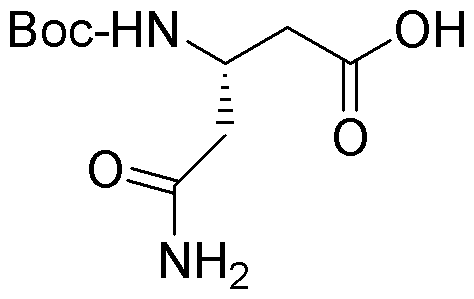Boc-L-b-homoasparagine is widely utilized in research focused on:
- Peptide Synthesis: This compound serves as a key building block in the synthesis of peptides, particularly in the development of therapeutic agents and research tools in biochemistry.
- Drug Development: It plays a crucial role in the design of new pharmaceuticals, especially in targeting specific biological pathways, enhancing drug efficacy and selectivity.
- Bioconjugation: The compound is used in bioconjugation processes, allowing for the attachment of biomolecules to drugs or imaging agents, which is essential in creating targeted therapies.
- Protein Engineering: Researchers utilize it to modify proteins, improving their stability and function, which is vital in developing enzymes and antibodies for various applications.
- Research in Neurobiology: It is explored in neurobiological studies to understand amino acid interactions and their effects on neuronal function, contributing to advancements in treating neurological disorders.
General Information
Properties
Safety and Regulations
Applications
Boc-L-b-homoasparagine is widely utilized in research focused on:
- Peptide Synthesis: This compound serves as a key building block in the synthesis of peptides, particularly in the development of therapeutic agents and research tools in biochemistry.
- Drug Development: It plays a crucial role in the design of new pharmaceuticals, especially in targeting specific biological pathways, enhancing drug efficacy and selectivity.
- Bioconjugation: The compound is used in bioconjugation processes, allowing for the attachment of biomolecules to drugs or imaging agents, which is essential in creating targeted therapies.
- Protein Engineering: Researchers utilize it to modify proteins, improving their stability and function, which is vital in developing enzymes and antibodies for various applications.
- Research in Neurobiology: It is explored in neurobiological studies to understand amino acid interactions and their effects on neuronal function, contributing to advancements in treating neurological disorders.
Documents
Safety Data Sheets (SDS)
The SDS provides comprehensive safety information on handling, storage, and disposal of the product.
Product Specification (PS)
The PS provides a comprehensive breakdown of the product’s properties, including chemical composition, physical state, purity, and storage requirements. It also details acceptable quality ranges and the product's intended applications.
Certificates of Analysis (COA)
Search for Certificates of Analysis (COA) by entering the products Lot Number. Lot and Batch Numbers can be found on a product’s label following the words ‘Lot’ or ‘Batch’.
*Catalog Number
*Lot Number
Certificates Of Origin (COO)
This COO confirms the country where the product was manufactured, and also details the materials and components used in it and whether it is derived from natural, synthetic, or other specific sources. This certificate may be required for customs, trade, and regulatory compliance.
*Catalog Number
*Lot Number
Safety Data Sheets (SDS)
The SDS provides comprehensive safety information on handling, storage, and disposal of the product.
DownloadProduct Specification (PS)
The PS provides a comprehensive breakdown of the product’s properties, including chemical composition, physical state, purity, and storage requirements. It also details acceptable quality ranges and the product's intended applications.
DownloadCertificates of Analysis (COA)
Search for Certificates of Analysis (COA) by entering the products Lot Number. Lot and Batch Numbers can be found on a product’s label following the words ‘Lot’ or ‘Batch’.
*Catalog Number
*Lot Number
Certificates Of Origin (COO)
This COO confirms the country where the product was manufactured, and also details the materials and components used in it and whether it is derived from natural, synthetic, or other specific sources. This certificate may be required for customs, trade, and regulatory compliance.


